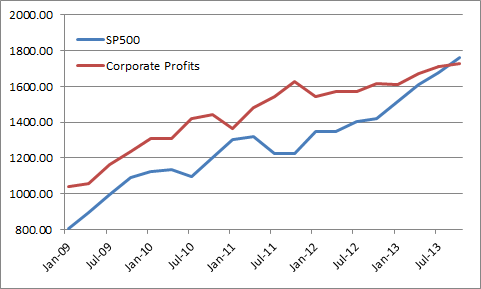There are two camps in the world when it comes to thinking about QE and the stock market. There are those who view QE as an asset swap that is marginally impactful, but vastly overblown by the mainstream media. And there are those who think QE is the equivalent of “money printing” which is manipulating stock prices and will lead to some sort of inevitable disaster. When considered in the scope of its market impact, the first camp tends to think that the market impact of QE (thus far) has been overstated and that the market has been driven more by fundamental factors (plus some level of multiple expansion as investors pay more for earnings – this is mainly a 2013 phenomenon as seen here). The other camp tends to think the rally in stocks is almost entirely Fed driven, fake and destined to end in disaster.
The disaster camp tends to show this chart all of the time (or, usually something with the axis more manipulated):
The QE is an asset swap camp tends to show this chart:
These two views can lead one to consider an interesting thought experiment. Consider, for instance, an environment in which the Fed continues to expand its balance sheet and corporate profits DECLINE. Which of the above charts do you think would correlate most closely with the stock market? In other words, do we really think the Fed is driving corporate profits and do we think that expanding their balance sheet will directly lead to an increase in profits and thus, higher stock prices? Or do we think that an environment with declining corporate profits would eventually cause market participants to realize that QE might not be the main driver of the market?
Feel free to discuss….
Mr. Roche is the Founder and Chief Investment Officer of Discipline Funds.Discipline Funds is a low fee financial advisory firm with a focus on helping people be more disciplined with their finances.
He is also the author of Pragmatic Capitalism: What Every Investor Needs to Understand About Money and Finance, Understanding the Modern Monetary System and Understanding Modern Portfolio Construction.




Comments are closed.